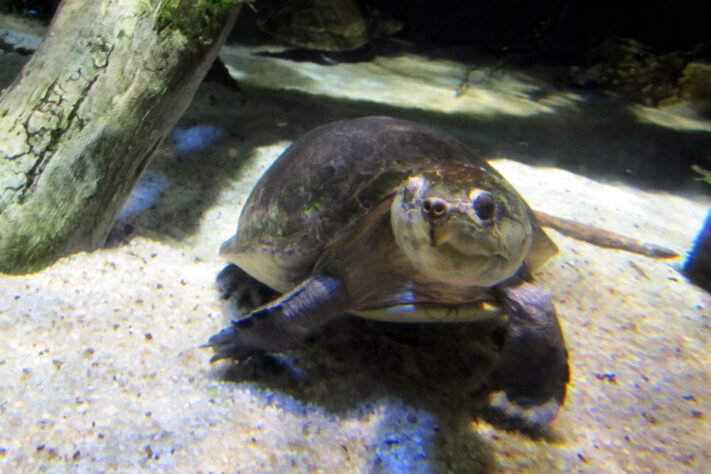African Sideneck Turtles
African Sideneck turtles, officially known as Pelomedusida, is a popular turtle species found primarily in the region of Sub-Sahara Africa. A freshwater turtle, their shells usually range from 5 to 18 inches. They get their infamous name because they are unable to squeeze their neck directly all the way back into their shell.
Instead, the African Sideneck turtle retracts its long neck sideways under the covering of their shell. This strange adaptation allows them to hide inside their shell when they are under attack from predators.
As a pet, African Sideneck turtles are a great choice. If cared for properly, they can easily live past 30 years. They are aquatic turtles, and therefore spend a lot of their time in the water.
How Long Can African Sideneck Turtles Be Out of Water?
The answer to this question is a little tricky.
Despite being an aquatic turtle, African Sideneck turtles can be out of water for weeks at a time.
The reason they can stay out of water for so long is because this is not uncommon in their natural environment. Many of the rivers in Sub-Sahara Africa (where they mostly live) can dry up for weeks and even month at a time. Because of this, African Sideneck turtles have learned to adapt to life without water.
That being said, their natural habitat is still in water, and therefore you should always provide them access to water. They are more prone to diseases when they spend extended periods of time outside of water.
African Sideneck turtle behavior
While African Sideneck turtle’s are usually calm and easy going, they can become aggressive with other species. If you try to put a fish or other small reptiles in the tank, the African Sideneck will probably try to eat them. You can definitely have two African Sidenecks in the same tank, but you should definitely make sure they have enough space (at least 100 gallons).
African Sidenecks are usually calm around humans, but they might become aggressive if they get nervous or feel threatened. For this reason it is best to not constantly pick up your African Sideneck.
Can African Sideneck turtles swim?
Yes, African Sideneck turtles can absolutely swim!
If you remember from the beginning of the article, I mentioned that African Sidenecks are aquatic turtles. This mean that the water is their natural habitat. African Sideneck turtles use their swimming skills to catch their food and evade capture from land predators.
How much water does an African Sideneck turtle need?
The amount of water your African Sideneck turtle needs is dependent on their size. I usually recommend 10 gallons of water for each inch of shell length. For example, if your African Sideneck has a shell length of 10 inches, I would recommend a tank with at least 100 gallons of water.
It is also not uncommon to house an African Sideneck in an enclosure. If this is the case, you just want to make sure that the turtle has a tube that is big enough for them to comfortably swim around. Secondly, you want to make sure that your turtle can easily access the water.
It is also important to make sure that your turtle can easily get out of the water. Despite being an aquatic turtle, the African Sideneck can still drown if they do not have an easy way to get out of the water.
Why do African Sideneck turtles have long necks?
Now you might be wondering why African Sideneck turtles have such long necks. You can probably guess that their long neck helps them in their hunting endeavors. A longer neck allows them to extend out further to capture prey in their mouth.
However, hunting isn’t the only advantage of having a long neck. An African Sideneck’s neck allows them to maneuver through the water quicker and more efficiently. Their long necks essentially gives them another flipper to swim with.
The Sideneck turtle’s long neck also plays a big role in their balance. In fact, having a long neck allows them to more easily flick back to their belly if they end up getting flipped over. In the wild, this ability to flip back over can be a lifesaving maneuver.
What do African Sideneck turtles eat in the wild?
In the wild, African Sideneck turtles are primarily on an omnivore diet. This means that they consume both plants and animal sources. When it comes to animals, these turtles most feed on insects, worms, and small fish.
If you have a pet African Sideneck turtle, I recommend feeding him/her a diet that consists of both vegetables and protein turtle pellets.

